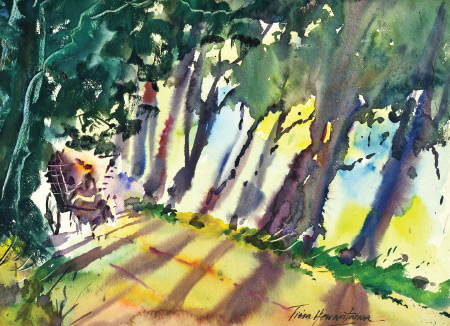Alternative solutions to watercolour painting problems
by Tissa Hewavitarana
The difference between a photograph and a painting is more than just
the surface appearance of things. With each stroke of the brush, the
artist expresses his own personality and feelings about the subject.
This applies particularly in a watercolour painting, in which every
brush mark remains visible and therefore, becomes and integral part of
the finished image. Beginners, have a tendency to be rigid and
inflexible in their brushwork because they lack confidence to let go and
adopt to the spontaneous qualities of watercolour.
 Do not be a slave to your subject, break loose from it and let your
enjoyment of it come through in your painting. Do not be a slave to your subject, break loose from it and let your
enjoyment of it come through in your painting.
For instance, take the painting I have done titled 'Evening shadows.'
Observe the energetic brush strokes that convey movement of the trees
and downward sweeping strokes that propel the eye.
Colour harmony
Thick glazes of green, violet, blue and yellow are used throughout
keeping the whole painting together through colour harmony. Loose, dry
brush strokes allow the picture to spread out, concentrating our
attention on the trees by the roadside, and the huge tree on the left
and the bullock-cart at the corner as the focal point. Every inch of the
painting is alive and vibrant with sweeping brush strokes.
It makes us feel the energy of the wind in the trees. Achieving the
energy and spontaneity, without losing control of the medium, needs
skill and this can only be gained through practice. The foreground trees
are mostly indicated by dark green patches and shadows play an important
role in conveying an impression of bright sunlight.
Brush strokes can only be effective only when your hand and arm are
relaxed. Hold the brush loosely and apply the paint to the paper lightly
but confidently.
To help you loosen up, it may be helpful to work on a larger paper
than you normally use, and with bigger brushes that encourage a more
expansive approach.
Try to convey the movement and energy inherent in living forms by
varying the speed, thrust and direction of your brush strokes.
The interaction of fingers, wrist and arm is important here. Use our
whole arm to make fast, sweeping brush strokes that capture the
turbulence of a stormy sky for fine and precise details.
Marked effect
Remember the way you use the brush, water and paint. They can have a
marked effect on the emotional quality of the finished work.
By varying the pressure on the brush, you can make lines that differ
from thick to thin in a single stroke. You can even 'lose' lines and
'find' them again, creating broken contours that lend rhythm to the work
and allow it to 'breathe.'
Broken contours also break down the barriers between one form and
another allowing them to link together harmoniously. One common mistake
made by beginners is putting rigid lines around everything so that the
finished painting does not look like a jigsaw.
Technical problems
Be aware of the emotional impact of the lines and strokes in your
painting and try to choose those which are compatible with the mood you
want to capture. To help you 'limber up' before starting a painting,
make random brush strokes and consider what emotions they convey.
Every painter is confounded by certain subjects that seem to cause
particular difficulties. When painting skies for instance, we encounter
most of the technical problems associated with controlling large areas
of wet paint.
Flowers are another popular painting subject, yet capturing their
delicate forms and subtle colours is no easy matter.
Many of the problems encountered, however, stem from the same source.
The student tries too hard to make a photographic copy of the
subject, and ends up with a dull picture. This lesson shows you how to
harness the expressive potential of watercolour to textures and forms
without overstating them.
Points to remember
*Watercolour paint can be removed from the paper with a clean brush.
Wherever the brush touches the background the wet paint is absorbed.
* The paper must have the right weight and must be specially made for
watercolour. Otherwise the colour will make a soggy patch on the paper
surface and it will not be possible to paint. |

